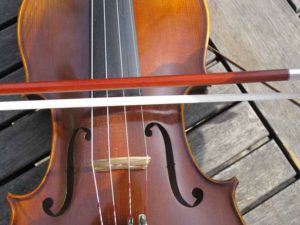Originally posted 2013-07-03 19:59:34.

Once you have the grip of the instrument under the chin sorted out, the next thing to address is the right hand’s grip on the bow. This can cause a great deal of trouble though in my opinion is not as tricky as the left hand. Again, the secret is to avoid tension; the hand must be relaxed. To do this, all four fingers and the thumb must be in contact with the stick, and all must be curved. This is hugely important. The most common grip errors are for the little or pinkie finger to lock and become straight and rigid. Do not allow this to happen. Another is for the pinkie to lift off the stick, which is also wrong. More subtle and harder to see but just as damaging is for the thumb to become stiff.
Hand Grip
The back of the hand should lead in a straight line from the forearm, even perhaps drooping a little and the bow should be gripped lightly. The wrist should be completely loose and able to move the hand from side to side quite freely; this is vital in order to play Strathspeys and other music that uses rapid bowing forms.
The bow itself must cross the strings at a right angle. This again is crucial. Finally you should use the whole bow from tip to frog right from the start.
What you will immediately find is that getting the perfect cross throughout the length of the bow will mean you have to alter the left arm and particularly the left hand grip. Be especially careful not to introduce tension into the left thumb while doing this. There is no one compromise grip that is correct for everyone and you will have to find your own. On the way make sure that you’re paying attention to everything I’ve said, to recap
- The violin should be gently supported on the shoulder by the weight of your chin. You should be able to hold it up without using your hand with no additional effort
- The neck and jaw should be quite relaxed—no “gripping” or “pinching”
- The shoulders should be totally relaxed
- The back should be straight and the head up
- The left elbow should be forward, under the instrument
- The left wrist should be cocked, with the back of the hand in line with the forearm
- The left thumb should be relaxed
- The right forearm should be horizontal with the back of the hand in line with it or drooping slightly
- The right wrist should be relaxed
- The right hand should be relaxed with only the tips of the fingers gripping the bow
- The right thumb and pinkie must be curved, relaxed and supple
- The bow must cross the strings at a perfect right angle
Sounds like a tall order and it is. You will have to practise a lot to get your grip right. I have to say here that more effort is not necessarily more progress. You should practise as much as you can, but try not to try when you do. Just let it flow. Pay attention to the basics—keeping the hands relaxed, the wrists loose yet cocked. Don’t try anything radical or flashy until you can get the basic positions and grips just right. This will take some time to perfect so relax and take it easy. However the effort you put in now in getting the basic technique right will pay off in spades for the rest of your life.
Should I stand or should I sit?
It doesn’t matter. The old joke is you stand to play the fiddle and sit to play the violin, but this is just a joke. Usually in trad sessions the players sit, just like classical players, and only stand to take a solo, just like classical players.
It is much easier to get the basic body position at the heart of good violin technique right if you stand, at least to begin with. Once your shoulders and upper back have learned to relax in the correct positions, then by all means sit if you wish or the situation demands it. I personally prefer standing anyway as I am fairly mobile as a player, so even if you don’t step-dance at the same time as you fiddle—something that is much more common than you may think—you may be more comfortable standing.
As an aside, many old-time trad fiddlers in Scotland and Ireland sang and danced as well as fiddled, and although I have to admit I don’t do this in public, my experiments suggest it is much easier to do standing up. Anyone who wants to see this for real should check out Natalie MacMaster. Not only is Natalie one of the finest trad fiddlers out there today, she is also a singer and dancer, and truly spectacular to watch.


